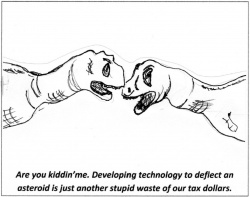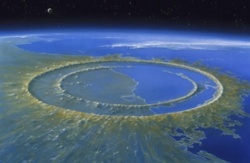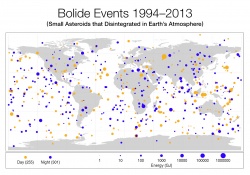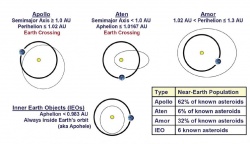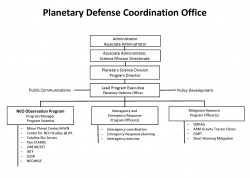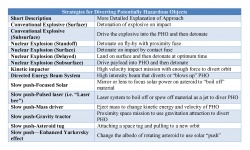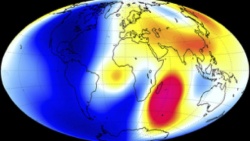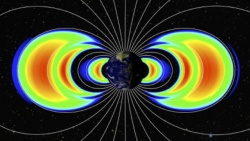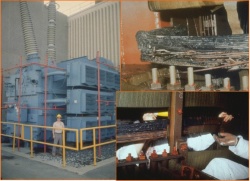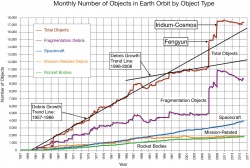The Farthest Shore – Chapter Fifteen Cosmic Hazards
From The Space Library
Chapter Fifteen Cosmic Hazards, Space Debris and Planetary Defense
Joseph Pelton, James Green and Heiner Klinkrad
15.1 Introduction
There is a seemingly simple question that most space experts would get wrong if they were to respond spontaneously without giving it much thought. This question is: “What is the largest spacecraft that has humans aboard it?” How would you answer the question? If you answered the International Space Station (ISS), you would be wrong. The precisely correct answer, of course, would be, planet Earth. This six-sextillion ton planetary mass is currently carrying about 7.5 billion passengers around the Sun at about 100,000 kilometers/hour or 66,000 miles per hour. By 2100 the number of space travelers on this giant spacecraft could be as large as 12 billion and our ship could be in serious peril from a range of cosmic hazards.
The fact that we are traveling through space at tremendous speed and with a minimum amount of shielding from cosmic hazards is appreciated only by few humans. If the earth was thought of as an apple, the protective atmosphere on which we depend for oxygen and protection from cosmic radiation would be represented by a layer thinner than an apple’s rind.
Only recently has there been significant awareness of hazards from such cosmic perils as asteroids, comets, coronal mass ejections, solar radiation flares, and even climate change. Moreover, fewer of us are aware that there is currently a movement of the location of the Earth’s magnetic poles that appears to be occurring. Our magnetosphere may be in the process of “flipping” (or more precisely “shifting”) as it has done numerous times over the history of the Earth. The shifting of the Earth’s magnetic poles will reshape the Van Allen Radiation Belts. Some theoretical models, as carried out by the Niels Bohr research institute in Germany, suggest that the natural protection from the sun offered by the Van Allen belts could with time, reduce down to a fraction of their current strength. Such a loss of basic protection from massive solar storms could imperil our electronic power grids, our gas, oil and water pipelines, and disable or greatly degrade our communications and networking systems.
Similarly, the degree of buildup in space debris that continues to grow in low, medium, and geosynchronous orbits is another example of possible hazards; as well as our lack of appreciation to their impact on human life and the health of its progress. Indeed, few people realize how a sufficient buildup up of space debris could create a runaway avalanche of debris that could spiral out of control. This phenomenon is known as “The Kessler Syndrome” after the NASA scientist that warned of this danger during the 1970s and 1980s. At the time, these warnings were largely ignored. But in fact, this deadly cloud of debris could eventually deny us future access to space. We could lose the vital services now offered by key application satellites that we use for communications, remote sensing, Earth observation, space navigation and precision timing, and weather and climate change monitoring.
For many millennia, it was thought that Earth was the center of the universe and the Sun traveled around the heavens to provide light to humankind. Only in the last few centuries have we understood the nature of stars, planets and galaxies and the reality of cosmic threats. Science fiction writer Larry Nixon famously said: “The dinosaurs became extinct because they didn't have a space program. And if we become extinct because we don't have a space program, it'll serve us right!” [1]This notable quote became even more widely known when used by space scientist, futurist and science fiction writer Arthur C. Clarke.
It is in fact the danger of humanity’s possible extinction that has led to space programs and focused efforts in increasing our knowledge about all categories of cosmic hazards; and to the creation of what is now called “planetary defense” programs. In fact, NASA has initiated Project Safeguard and space agencies around the world as well as the United Nations Committee on the Peaceful Uses of Outer Space have focused efforts to identify and analyze cosmic hazards. But unfortunately, the public has remained generally skeptical and cartoons such as the one below from popular press have been clear in expressing that opinion. (See Figure 15.1.)
But over time the reality of potentially hazardous asteroids have become increasingly clear. Imaging instruments on the International Space Station have provided color pictures of the crater created by the giant 6 km diameter asteroid that hit Earth about 66 million years ago (See Figure 15.2). This mass extinction event was the equivalent of many thermonuclear bombs exploding. The resulting dust and debris particles shadowed the sun and led not only to the extinction of the dinosaurs but of about 75% of Earth’s flora and fauna as well. By causing the extermination of the dinosaurs this event led to the rise of mammals and ultimately the dominance of homo sapiens across the globe.
Science has and continues to provide information on the nature of the millions of near earth asteroids, their orbits and the incidence of possible collisions. Indeed, we have learned that Tunguska asteroid, an approximately 40-meter asteroid, which impacted a remote part of Siberia on June 30, 1908 created devastation over an area equivalent to the Bay Area of San Francisco. This event had totally destroyed all trees within kilometers of the impact area. Data analysis of this strike tells us that 30 to 35 meter asteroids are sufficiently deadly to be so-called city-killers.[2]
Recent studies of the frequency of asteroid impacts suggest that past estimates have been much too low. B612 is a publicly funded organization that expresses concern about protecting the Earth from asteroid impacts and publicizes world-wide planetary defense issues. Former astronaut Ed Lu, the head of B612 held a press conference to announce the results of new data from satellites developed to detect nuclear explosions on the ground. The data indicates that asteroid impacts on Earth are three to ten times more numerous than previously thought.[3] What Ed Lu was doing was to publicize the following chart of asteroid strikes prepared by NASA’s Planetary Defense Coordination Office (PDCO) to show the frequency and random distribution of large-scale asteroid (called bolides) around the world.[4]
The larger dots in the Bolide Events chart, that represent strikes with energy levels of a hundred thousand to a million joules, are more than sufficiently powerful to wipe out a major city such as New York, Tokyo, Beijing, London, Paris or Mexico City. Indeed, the Tunguska impact has been estimated to have been equivalent to the explosion of a 10 to 15 megaton atomic bomb.[5](See Figure 15.3)
The most significant message of this chapter is not only that the danger of modern human civilization of a significant asteroid strike is greater than most people think. In fact, the key message is that a large variety of cosmic hazards could threaten life in the modern world and that people and the global infrastructure on which modern life depends are most certainly at risk. The conclusion is increasingly clear that long-term human survival will depend on what is often called “planetary defense”, and other efforts to defend and protect humans from cosmic hazards will be critical for the preservation of life on Earth. The remainder of this chapter will therefore address each of these cosmic hazards, describe the dangers, and examine what might be done in the field of planetary defense to protect Earth and the life that it harbors.
15.2 Planetary Defense in the Anthropocene Era
Geologists consider the time since 1950 a new “epoch” called the “Anthropocene epoch”. This formally declares that we have evolved from the Holocene epoch. This constitutes a new geological time during which human impact on the planet becomes the predominant driver of Earth’s geological transformations. The survival of human life during the “Anthropocene era”, will may also depend on various global efforts to survive cosmic threats that could threaten their very existence. Cosmic threats include not only a massive strike of a comet or asteroid on a city or country, but a wide range of dangers that could disable our power, communications and networking facilities as well as our transportation systems, water, oil and gasoline supplies and other resources on which billions of people are now essentially dependent.[6]
Efforts to mitigate and cope with future hazards that threaten the modern infrastructure on which we heavily depend have indeed already begun on a global level. The United Nations (U.N.) General Assembly in December 2013 endorsed efforts to create a global “International Asteroid Warning Network (IAWN)” and a “Space Mission Planning Advisory Group (SMPAG)”. The objective of the IAWN is to work with the Minor Planet Center and the Safe Guard Institute in Italy and other relevant organizations to share information worldwide on potentially hazardous asteroids that might impact Earth. Whereas, the role of the SMPAG is to assist with systematic planning of global efforts undertaken to divert any potentially highly hazardous asteroid detected that might strike our planet.[7]
In addition, there is, within the U.N. Committee on the Peaceful Uses of Outer Space, a Working Group on the Long Term Sustainability of Space-based Activities. This working group addresses such issues as solar storms and space debris. The U.N. Committee on the Peaceful Uses of Outer Space, the International Astronomical Union (IAU), the Committee on Space Research (COSPAR), the International Academy of Astronautics (IAA), the Safeguard Foundation in Italy, the Association of Space Explorers, the Minor Planet Center in Cambridge, Massachusetts, the various space agencies around the world and many more institutions are working on cataloguing and studying the nature of cosmic hazards. Even more importantly, they are seeking to create new means to warn against cosmic hazards and to protect and defend against these threats. Today NASA is spending up to ten times more on research to aid with asteroid warning and defense based on new data shown above then it did in 2006.
The European Space Agency’s “Swarm” satellites and the NASA Magnetospheric Multiscale Mission (MMS) indicate that there are potentially dangerous changes to the Earth’s magnetosphere and by extension the protective shielding provided by the Van Allen belt. This suggests that we will need to focus on identifying and developing more strategies to shield Earth from destructive solar Coronal Mass Ejections (CMEs). In essence, the world community needs first to better organize and identify best strategies in monitoring and understanding potential threats to Earth and especially the vulnerabilities to our global infrastructure. Second, we need to define and implement agreed international plans, systems, and processes to execute planetary defense against this growing list of threats. In the following sections, we will discuss each threat individually.
15.3 Asteroid and Comets Threats.
There are various types of things that go bump in the day and night and there are some confusing and overlapping terms that are applied to these cosmic threats. A Near Earth Object (NEO), that can include both asteroids and comets, are those that can come with 0.3 AUs (i.e. astronomical units or the distance between the Earth and the Sun). This means as close as 45 million km from Earth. The various types of Near Earth Asteroids (NEAs) are shown in Figure 15.4. Those particularly important asteroids that can get within 7.5 million kilometers (0.05 AUs) from Earth and are larger than 140 meters are defined as Potentially Hazardous Asteroids (PHAs). Currently there are just over 1750 (1756 is the current count at the end of Dec. 2016) of these type space rocks that are considered the most dangerous. They have been carefully identified and are closely monitored. Near Earth Asteroids that have orbits of special concern are defined in Figure 4 below. In addition, astronomers are continuously monitoring any near-Earth comets that passes within 0.3 AUs of Earth.
In the U.S., legislators first instructed NASA to find all asteroids that are 1 kilometer or larger that are potentially hazardous. This goal was completed by the end of 2010. Congress also passed the NASA Authorization Act of 2005 which required NASA to “…plan, develop, and implement a Near-Earth Object Survey program to detect, track, catalogue, and characterize the physical characteristics of near-Earth objects equal to or greater than 140 meters in diameter in order to assess the threat of such near-Earth objects to the Earth. It shall be the goal of the Survey program to achieve 90 percent completion of its near-Earth object catalogue within 15 years [by 2020].” NASA has worked diligently on this utilizing both ground-based and space-based telescopes.
There are literally many millions, if not billions, of asteroids and other small bodies in the Solar System. These are left over from the birth of the sun and the planets. Clearly locating modestly-sized asteroids, which are typically black, against the dark, cold void of outer space has been a dif-ficult task. Yet such a comprehensive survey to systematically find all of the space rocks that could threaten Earth is key and a necessary task; and will likely take many more years to complete.
Another very difficult task will be to find all of the Near Earth Comets (NECs) that might crash into our planet. A NEC is defined as a comet that might come within 0.3 AUs of Earth (or about 45 million kilometers). Comets come from, not only within the inner solar system but also the outer most regions of the Solar System known as the Oort Cloud which is approximately one light year away—beyond Pluto. Furthermore, even if detected, Oort Cloud comets are much harder to control and divert from their orbits because of the enormous speeds and great kinetic energy they achieve by the time they have reached the inner Solar System. The good news about comets is that they are most likely to be captured by the enormous gravity wells represented by the Sun and Jupiter and even Saturn as opposed to smashing into Earth. Gravity wells are a conceptual model of the gravitational field surrounding a body in space – the more massive the body, the deeper and more extensive the gravity well associated with it. Most of the wayward comets that travel into the inner Solar System are captured by the gravity of these large bodies and thus the risk of their hitting Earth is greatly diminished.
Many organizations cooperate in the mission to find asteroid and comet space hazards. The various space agencies of the world and dedicated observatories are working on finding and registering the orbits of PHAs. NASA and ESA and many space agencies are working on space situational awareness, as well dozens of observatories—large and small-- have important asteroid spotting work underway.[8]
The UN Committee on the Peaceful Uses of Outer Space (COPUOS) has been addressing the cosmic hazard of asteroids and comets for some time. The UNISPACE 3 Conference set up Action Team 14 to specifically address the potentially harmful asteroid problem. After intensive discus-sions, this Action Team agreed to set up two international bodies. One was the International Asteroid Warning Network (IAWN) and the other was the Space Mission Planning Advisory Group (SMPAG). This concept was unanimously agreed by the UN COPUOS and on December 2013.[9]
15.4 Strategies to Cope with Potentially Harmful Asteroids and Comet
The Planetary Defense Coordination Office (PDCO) was recently established by NASA to coordinate planetary defense related activities that are occurring world-wide in order to address and plan a response to the asteroid impact hazard. The PDCO leads the U.S. national and international efforts to detect any potential for significant impact of planet Earth by natural objects, appraise the range of potential effects by any possible impact, and develop strategies to mitigate impact effects on human welfare. Table 15.1 shows the organizational structure of the PDCO.
The PDCO has three major elements: the NEO Observation Program, the Interagency and Emergency Response Program, and the Mitigation Research Program. The NEO Observation Program organization in Figure XX is the strongest effort and has focused on finding and charting the orbits of potentially hazardous asteroids and comets to attain the earliest possible warning of a catastrophic strike that would be of major planetary consequence. This activity is the legacy of the Space Warn system and dates back to 1998.
The question remains as to what do we do if a serious threat is identified for a location somewhere in the world? The IAWN has the task to report this throughout the world. The NASA program officer on the IAWN will report through the management chain which will report to the U.S. President for threats in the U.S. The Space Mission Planning Advisory Group (SMPAG) has been working on studying a variety of mitigation options. Some of these options range from very small and modest to the very large impactors and disrupters powered by space missions. On the small end, there are efforts such as the Planetary Society’s “Laser bees” project. This effort proposes to send a number of very small lasers designed to burn holes in a threatening asteroid so as to create small jets spewing forth from the body in order to create a tiny variation in its orbit over months and years until it is no longer a threat. Midsized threats may be “slow pushed” out of the way by gravity if there is enough time for a large-massed mission to ride alongside the asteroid. On the opposite end of the scale is the idea of sending a thermonuclear device or tactical nuclear weapon into space and detonate it so as to divert its orbital path. These powerful tools that would definitely be considered space weapons would represent the options of last resort if the threat was detected within a very short notice and thus offer no time for longer-term solutions.
Table 15.2 below covers explosives, directed beam systems and so-called “slow push” systems indicate a range of options that might be used to divert a potentially hazardous object. This includes a compilation of strategies that have variously been identified by NASA, other space agencies and researchers in the field.[10]
The problem is that essentially all of the short-term solutions would require launching space weapons and a special international exception to the Outer Space Treaty would be required to proceed with this approach. Furthermore, the above strategies might be used effectively against potentially hazardous asteroids, but comets from the Oort Cloud, because of their much higher speeds and typically large inclinations, present a much more difficult problem. Only long-term advanced warning capabilities and the ability to use gravitational assist to build up the enormous speed needed to rendezvous with a threatening comet may be necessary to mitigate these threats in the future. This was the technique used to build up the great velocity that was needed to carry out the Rosetta mission that landed on Comet 67P/Churyumov–Gerasimenko. In short, we would need a very long lead time given today’s launch technologies and speeds in order to allow protective action and diversion of a comet.[11]
15.5 The Changing Magnetosphere and Its Impact on by the Van Allen Belt that Protects Us
There are currently two scientific satellite systems in orbit seeking to measure changes to Earth’s magnetosphere. These satellites are the European Space Agency’s Swarm and NASA’s MMS Satellites. The sensors on the satellites are confirming shifts in the magnetic field and a shifting of the magnetic poles. Swarm was launched in Nov. 2013 before the NASA MMS satellite and began producing data in 2014. As a result, ESA scientists have confirmed that they have sufficient data to support the theory that a magnetic shift of the Earth’s poles is taking place. This seems well ahead of the pattern of the normal shift occurring every 66,000 years. Figure 15.5, that was prepared from data provided from the ESA Swarm satellites, indicates a lessening in the magnetic field in the blue areas and with red to indicate a significantly strengthening magnetic field.[12]
This may have many scientific, technical and practical impacts, but the impact that the shifting magnetic poles and the re-shaping of Earth’s magnetic field and the shifting shape of the Van Allen belts could be very big indeed. Today the Earth’s magnetic field and the Van Allen belts are key to shunting aside the racing ions from a coronal mass ejection. Today it is the geomagnetic shielding that helps protect us from the impact of massive solar storms. This natural magnetic shielding helps divert these million kilometer per hour solar storm ions to be diverted from the equatorial and moderate climes regions of Earth toward the polar region. If our natural solar protective shields are lost or moderated, this could be of enormous concern. This is because what protects much of our modern infrastructure today. Our electric grids, telecommunications and information systems and satellite are what we increasingly are dependent and their loss could be catastrophic. (See Figure 15.6).
Currently, if a stream of ions from a coronal mass ejection, travelling at between 1 million to 3 million kilometers an hour, were to encounter the Earth, most of the ions would be pushed toward the poles rather than blasting the inhabited parts of Earth. But modeling of the Van Allen belts during the magnetic shift suggest that the shielding effects of these radiation belts might be reduced to 15% of their present strength.
Why should we be worried about solar flares and Coronal Mass Ejections (CMEs) and what is the difference between these two types of solar events. A flare that is an electromagnetic emission from the Sun and a coronal mass ejection is a gigantic mass of ions that are spewed forth from the Sun’s corona. A solar flare is a powerful and sudden emission from the Sun that can vary in its energy level from 1018 to 1025 joules (1020 joules is perhaps typical while 1025 is a truly enormous energy release equivalent to a billion megatons of TNT) and its EM frequencies from X-rays to higher. Flares are classified with progressively higher energy that start with A1 through A9, then B1-B9, C1-C9, M1-M9 and finally X1-X9. Solar flares are a concern mainly in the following terms: damage to space craft and astronauts traveling in outer space; genetic damage to living organisms here on Earth; and the ability of solar flares to trigger skin cancer in humans and animals.
But there is a bigger danger emanating from the Sun. A significant percentage of the time--such as 30% to 50% of the time-- solar flares are accompanied by a magnetic reconnection in the Sun’s coronal that spews out a massive amount of super accelerated ions. These events are called coronal mass ejections (CMEs). The ions are actual mass ejected from the Sun as opposed to electromagnetic flares. These ions are expelled with great force and speed and if they come out on a pathway that hits the Earth these events can do great damage to satellites, power grids, pipelines and electronic systems.
In 1859 the CME known as the Carrington Event was so powerful that it set fire to paper in telegraph offices. The Northern Lights were suddenly seen as far south as Central America and the resulting red-aurora covered a significant portion of the Earth[13]. Lesser CME events have, of course, occurred more recently. The Montreal Event of 1989 took out power transformers and damaged the power grids from Chicago to Montreal (See Figure 6). In 2003, the Halloween event took out power in Scandinavia.
CME events can burn out transformers, disable pipeline controls, and perhaps take out the now omnipresent Supervisory Control and Data Acquisition (SCADA) controllers. SCADA may not be a household word but millions if not billions of SCADA systems now automate the entire world. Traffic signals, water and sewer system controls, transportation systems, even elevators, escalators, and lighting systems are under their automated and programmed control. Today SCADA computer control systems are the “programmed brains” of a vital infrastructure all over the world. Another vulnerable victim to CME events could be the world’s satellite navigation systems. The Global Positioning System (GPS) and other satellite navigation systems are used to provide guidance for missile systems, control aircraft take off and landing ,and even provide precise time coordination for the Internet. In 1859 the Carrington event managed to set some telegraph offices on fire[14]. Today such a CME could create a natural ElectroMagnetic Pulse (EMP) that could, depending on its magnitude, disable a significant amount of the world’s vital electronic, communications, information, and transportation infrastructure.[15](See Figure 15.7).
15.6 Defending Against Solar Storm
The conventional wisdom is that nothing can be done to protect against violent solar storms that has a violent power of almost unimaginable strength. Yet, human science continues to develop new capabilities and a range of protective systems that might be deployed. Recently governments have begun to take solar storms seriously as the extent of our vulnerabilities have begun to be more clearly understood. A study by Lloyds of London and technical consultants estimated that a massive CME event might cause up to $3 trillion dollars (U.S.) in economic damages and income losses. A NASA study projected that there was perhaps a 12% chance of a major solar storm with catastrophic impact on vital infrastructure occurring within the next decade. A National Intelligence Council study within the United States put together a list of seven “black swan” events that could have devastating impact on the global economy and a major CME event was one of their projected possible disasters.
On October 13, 2016, then President Barack Obama signed an Executive Order that assigned specific responsibilities to NASA, the U.S. Department of Defense, Homeland Security and the National Science Foundation to investigate vulnerabilities presented by a major solar storm and to undertake protective and reactive programs. In the United Kingdom, legislative action was taken to institute a terrestrial precise timing synchronization for the Internet. Designers of satellite systems have undertaken the task with the use of heavy duty circuit breakers to make space networks more resistant to natural or man-made electromagnetic pulses (EMPs). Such EMPs can come from either a nuclear detonation in space or a solar storm ionic blast.
Beyond these modest defensive actions, however, there are also new and innovative studies seeking to explore truly revolutionary planetary defense systems. These ambitious efforts look ahead to a time when the Van Allen belts protective shielding are significantly diminished. One idea would be to deploy at Lagrangian Point One (L-1) (approximately 1.5 million km from Earth) new space shielding system that uses 1 to 2 Tesla of magnetic deflection to divert strong CME events. There are many challenges to such a protective shielding system. These challenges include: (i) accurately stabilizing the shielding system on a long term basis, especially given the fact that L-1 is not a highly stable point and even electronic thrusters still consume fuels; (ii) the shielding system must not only block the solar ionic blast, but also manage to stop tailing around the shielding system that would still hit Earth; (iii) the size of the shielding system to block the CME ions and to stop the tailing around the shield will have be much larger than the first estimates because of the large force of the tailing effects.[16]
Despite the many scientific, engineering and construction difficulties, the creation of an L-1 based system, might also offer significant opportunities to accomplish other objectives. These opportunities include the possibility of creating a solar power satellite system to beam clean energy back to Earth, creating a solar power modulation system to lessen climate change heating of the planet, and possibly creating a super low gravity staging center for solar system wide transportation. The interesting aspect of an L-1 solar shielding system is that an equivalent system could in theory be designed for Mars to stop solar wind from stripping off the Martian atmosphere. An effective solar shield for Mars could allow over time the regeneration of a viable atmosphere and the possible terraforming of the Red Planet.[17]
15.7 The Threat of Orbital Debris
Space Weather and Potentially Hazardous Objects are natural phenomena that are a serious area of concern. In fact, humans have managed to create their own serious cosmic hazard in the form of orbital space debris. When NASA scientist Donald Kessler first raised concerns that human launch operations might lead to a serious problem with space debris nearly fifty years ago, the possibility that this could be a serious future space safety issue was generally dismissed. At the time natural phenomena such as micrometeorites and space weather seemed to be a much more serious concern. Over the years upper stage rockets, defunct satellites, explosive bolts used to separate rocket stages, exploding batteries and fuel tanks, and even dropped tools by astronauts and cosmonauts have added up in a serious way. As a result, there are present concerns about collisions between debris elements. Removal of large satellites that are out of service and no longer controllable is therefore seen as a priority in combating debris build up.
In 2007 the Chinese military shot down one of their out-of-service weather satellite and in the process added well over 2000 newly created and trackable pieces of debris.[18]This was followed in 2009 with the collision of a Russian Cosmos 2251 satellite with an active Iridium 33 satellite. This collision not only knocked out an active spacecraft but this huge space wreck added yet another over 2000 new trackable pieces of debris.[19]Figure 15.8 shows the rapid and continuing build up of space debris over the past decades . This graph highlights how just the two events in 2007 and 2009, and fragmentation in general, (See pink line) represent prime causes of space debris.
Currently over 22,000 pieces of debris larger than a softball are being tracked in low earth orbit. Space situational awareness radar equipment to track debris and missile launches costs billions of dollars of capital investment in equipment and operational expenses. When the new S-band Radar “Space Fence”, that is being installed on the Kwajalein Atoll, Republic of the Marshall Islands by the U.S. military, is complete it will be able to track up to 250,000 pieces of debris in low earth orbit that are the size of a ping pong ball.[20]The number of space debris elements that are just 1 mm in size (think of particles such as paint chips) now number in the millions. The problem is that even space junk that is less than a centimeter in size has the kinetic energy sufficient to pierce an astronaut’s space suit or even crack a window on a spacecraft. The 2013 Hollywood movie “Gravity” may not have been entirely scientifically correct in its portrayal of space debris and how it might destroy the International Space Station, but it did an excellent job in bringing to the public’s attention the actual existence of space debris and the fact that it could indeed be a very serious problem.[21]
Recent projections from the Delta software model developed by the European Space Agency forecasts that every 5 years or so there will be a collision and debris will continue to mount even with no new launches. All of the various models developed by space agencies seem to agree that a collision will occur every 5 to 10 years if the current space environment around Earth remained the same.[22]But of course there are multitudes of new launches planned. Large scale low earth orbit constellations for remote sensing, communications and networking are now being deployed. The so-called One Web LEO constellation alone may launch nearly a thousand small satellites when counting operational and spare spacecraft.
The good news is that with new capabilities developed for on-orbit servicing and refueling, it will very soon be technically possible to remove defunct satellites from orbit or even to salvage parts from an old or uncontrolled satellite to reuse them for another mission. The range of technical approaches that may be used for this purpose is currently quite wide and while most options are space based, there are a number of options that include ground based lasers or directed energy beam systems to maneuver around debris or to bring debris into a rapidly decaying orbit. The approaches in space vary from passive systems (i.e. solar sails or inflatables) already on-board spacecraft that can be deployed at end of life to create drag and thus aid de-orbit to active debris removal systems.
These active orbital removal systems include the following: (i)Various types of electro-dynamically powered systems such as the so-called system known as the “Electro-Dynamic Debris Elimination (EDDE) systems; (ii) Various types of robotic systems that would use propulsion to deorbit with a defunct spacecraft or rocket stage attached; (iii) robotic systems that would use a harpoon to attach a propulsive deorbit system; (iii) tether deployed nets; and (iv) glues, epoxies adhesives, nerf balls, etc. that create atmospheric drag—just to name some of the possible options.
In addition to various national Space Agencies' efforts (e.g. NASA, DLR of Germany, and the Swiss Clean Space One) and the U.S. Defense Advanced Projects Agency work on this effort there are at least three active commercial efforts to provide on-orbit services, refueling, or active deorbit services. These projects include the McDonald-Dettwiler (MDA) SIS system in Canada, the Vivisat activity in the U.S., and the Cone Xpress of Orbital Recovery Limited of England. These corporate ventures are offering services that include on-orbit refueling, servicing, re-deployment to new orbits, or potentially active debris removal.[23]
The issue of space debris removal and its costs have been discussed for many years, but to date there has been very limited action other than efforts by the InterAgency space Debris Committee (IADC) and UN COPUOS efforts to create International Guidelines on Space Debris. The concern is that the problem is going ever more challenging and difficult to address. Heiner Klinkrad, former head of the European Space Agency space debris office has clearly stated the problem thusly: “Whatever we are going to do, whatever we have to do, is an expensive solution….We have to compare the costs to solving the problem in an early stage as opposed to losing infrastructure in orbit in the not-too-distant future.”[24]
In the case of on-orbit missions to de-orbit potentially dangerous space junk, there are not only difficult mission engineering concerns, but also key questions of liability. The UN “Liability Convention” specifies that the registered “launching state” has absolute liability if there is an accident. The provisions of the Liability Convention did not anticipate the problem of growing space debris build up and thus this Convention offers no incentives to remove space debris. Proposals to amend the Liability Convention to offer incentives to remove space debris have, however, not garnered support needed to change this Convention.
The most that has been achieved is that the InterAgency space Debris Committee (IADC) has created a list of recommended guidelines for governments to follow and thus prevent the creation of additional space debris. The UN Committee on the Peaceful Uses of Outer Space, with over 80 members, was able to endorse the IADC guidelines with a few amendments and these were in turn agreed upon within the UN General Assembly. These guidelines are, however, “voluntary” and still are completely stringent. The French Space Operations Act (FSOA) that is now in full force imposes fines on satellite operators that are not able to deorbit a satellite within 25 years of end of life. Perhaps other nations will follow the French Governments example and impose penalties on those that risk the creation of new space debris.
The intricacies of space policy and global space governance are complex and often involve difficult trade-offs. The proposed new large scale small satellite constellations are well suited to Internet access and networking services in underserved developing countries and lower cost remote sensing satellite services. However, the deployment of such satellite constellations without regulatory constraint, risks the possibility of increasing the space debris build up. There is currently no procedures within the International Telecommunication Union (ITU) for inter-system coordination or spectrum allocation that imposes a limitation on satellite deployment to avoid space collisions nor are there any procedures within the United Nations General Assembly that controls how many satellites might be launched.
The UN Committee on the Peaceful Uses of Outer Space has created a Working Group on the Longer Term Sustainability of Outer Space Activities that is seeking to address problems such as space debris and solar storms. Just as there are serious environmental pollution issues and over consumption of natural resources here on the planet, there are now serious considerations as to what to do with regard to space traffic management, proliferating space debris, and perhaps even using space systems to provide clean energy to Earth, shield the Earth from solar storms, and remove space debris from Earth orbit.
15.8 Conclusion
The Earth is constantly bombarded by cosmic material and in recent times, some impacts have been significant. Today we believe that there is a low probability of a civilization ending NEO impact in the next 100 years. But we must also realize that we haven't completed the comprehensive survey that would make that statement a certainty. Now that we recognize that NEOs can be a substantial threat to civilization on planet Earth we must remain vigilant and continue to monitor the skies for such threats since the ultimate source of NEO is the asteroid belt or the Oort Cloud where there are an endless supply of small bodies to draw from.
The obvious first level type of response to natural cosmic hazard threats would be to plan for reasonable disaster responses or protective systems that could minimize the extent of the damage and to design backup systems. This would include heavy duty circuit-breakers in SCADA systems, power grids or satellite networks. It also would involve creating terrestrial synchronization systems to back up GPS satellites or create additional restoration capabilities. Furthermore, sophisticated training exercises for military or disaster recovery crews that simulate various conditions of a major asteroid strike or a Coronal Mass Ejection event that would destroy electrical grid systems, disable key satellite facilities, or take out critical electrical or pipeline supply systems.
The other second level response requires truly innovative thinking and breakthrough ideas. This might be the idea of creating an electromagnetic shield against solar storms that might hit Earth when the magnetic poles shift or even an electromagnetic shield for Mars to allow it to regenerate an atmosphere. Or it might involve redeploying a Near Earth Object to a lunar orbit so that might be used for both resource recovery (space mining) or as an emergency space billiard ball to deflect an asteroid on collision course to hit Earth.
Currently space agencies see their prime role to explore space, develop new space applications and engage in space science. The various space agencies do not currently see their prime mission as defending Earth against cosmic hazards or cleaning up space junk from near Earth space. As the very real threat of cosmic hazards becomes clearer in coming years this, however, might change. If this should be the case it might open a whole new series of opportunities to develop new capabilities that might be “spin-off” aspects of such a new prime mission. Planetary defense ini-tiatives and debris removal might lead to new breakthroughs in space robotics, space mining capabilities, new tools to combat climate change, planetary settlement, and even much more visionary capabilities such as terraforming of Mars or raising of Earth orbit to cope with the expansive growth of the sun.Footnotes
- ^ Quote of Larry Nixon that was widely circulated by requiting by Arthur C. Clarke www.brainyquote.com/quotes/keywords/asteroid.html last accessed Jan. 30, 2017
- ^ William Hartman, 1908 Siberia Explosion“ Planetary Science Institute, https://www.psi.edu/epo/siberia/siberia.html Last accessed in Jan. 2017
- ^ Benjamin Hart, “Far More Asteroids Have Hit Earth than Thought” Huffington Post, April 19, 2014 http://www.huffingtonpost.com/2014/04/19/asteroids-cities_n_5178708.html
- ^ “Bolide Events 1994-2013” Jet Propulsion Labs, Nov. 14, 2014 http://www.jpl.nasa.gov/images/asteroid/20141114/bolide20141114-full.jpg
- ^ Final Report of the Action Team on Near Earth Objects, Feb. 11-12, 2013, p. 9 http://www.unoosa.org/pdf/limited/c1/AC105_C1_L330E. pdf
- ^ Sakah Kaplan “Why 1950 may be when Earth entered a new epoch” Washington Post, Sept. 6, 2016 p. E2.
- ^ IAWN & SMPAG, December, 2013 http://www.unoosa.org/oosa/en/ourwork/topics/neos/smpag_iawn.html
- ^ Joseph N. Pelton and Firooz Allahdadi (editors) Handbook of Cosmic Hazards and Planetary Defense , (2013) Springer Press, NY. See section on asteroid
- ^ General Assembly resolution 68/75 (December 2013) http://www.unoosa.org/documents/pdf/smpag/IAWN_SMPAG.pdf
- ^ Near-Earth Object Survey and Deflection Analysis of Alternatives Report to Congress March 2007 http://neo.jpl.nasa.gov/neo/report2007.html Also see: Joseph N. Pelton and Firooz Allahdadi, Handbook of Cosmic Hazards and Planetary Defense (2015) Springer Press, NY.
- ^ Rosetta: A European Space Agency Cornerstone Mission (January 2016) http://rosetta.jpl.nasa.gov/
- ^ ESA Observing the Earth, January 30, 2017 http://www.esa.int/Our_Activities/Observing_the_Earth/Swarm/Swarm_reveals_Earth_s_ changing_magnetism
- ^ Green, J. L. and S. A. Boardsen, Duration and extent of the great auroral storm of 1859, Adv. Space Res ., doi:10.1016/j.asr.2005.08.054, 2006.
- ^ Green, J. L., S. A. Boardsen, S. Odenwald, J. E. Humble, and K. A. Pazamickas, Eyewitness reports of the great auroral storm of 1859, Adv. Space Res., doi:10.1016/j.asr.2005.12.021, 2006
- ^ Joseph N. Pelton, Indu Singh, and Elena Sitnikova, “Cyber Threats, Extreme Solar Events and EMPs” Inside Homeland Security, Winter 2015, http://www.abchs.com/ihs/WINTER2015/Pelton_Singh_Sitnikova_92.php
- ^ Joseph N. Pelton, Scott Madry, and Ram Jakhu, “Defending Earth against Cosmic Hazards?” Room Space Journal , Winter 2015/2016 http:// room.eu.com
- ^ Joseph N. Pelton “Our Changing Would and the Mounting Risk of a Calamitous Solar Storm” Room Space Journal , Summer 2016 http:// room.eu.com
- ^ Zachary Keck, China Conducted Anti-Satellite Missile Test, Jul 29, 2014 http://thediplomat.com/2014/07/china-conducted-anti-satellitemissile-test/
- ^ 2009 Iridium-Cosmos Collision Fact Sheet (Updated Nov. 10, 2010) https://swfound.org/media/6575/swf_iridium_cosmos_collision_fact_ sheet_updated_2012.pdf
- ^ Space Fence (AFSSS S-Band) http://www.globalsecurity.org/space/systems/space-fence.htm
- ^ Gravity: Plot summary http://www.imdb.com/title/tt1454468/plotsummary
- ^ Stability of Future LEO Environment, IADC-12-08, Rev. 1, Jan. 2013, http://www.iadc-online.org/Documents/IADC-2012-08,%20Rev%20 1,%20Stability%20of%20Future%20LEO%20Environment.pdf
- ^ Joseph N. Pelton, New Solutions for Orbital Debris Removal (2015) Springer Books, New York, See particularly Chapter 2.
- ^ Elizabeth Howell, Universe Today: Space and Astronomy April 26, 2016 Newshttp://www.universetoday.com/101790/experts-urgeremoval-of-space-debris-from-orbit/

